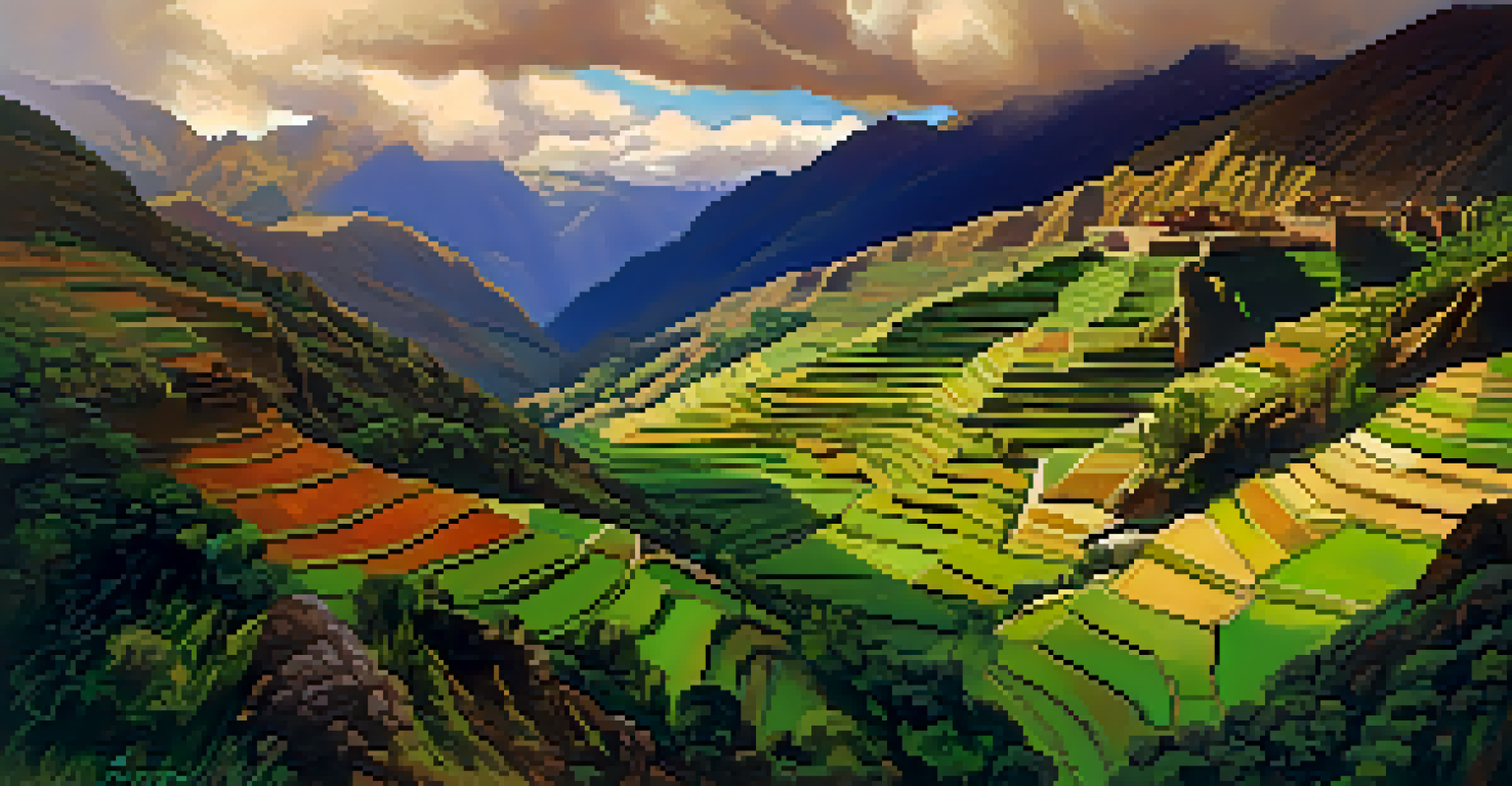A Complete Guide to Peru's National Parks and Their Trails

Introduction to Peru's National Parks and Their Importance
Peru is a land of breathtaking landscapes and rich biodiversity, making its national parks some of the most precious areas in the country. These parks not only protect a wide range of flora and fauna but also preserve cultural heritage and indigenous communities. Each park has unique features that attract nature lovers, trekkers, and adventurers alike.
In every walk with nature one receives far more than he seeks.
From the Andes mountains to the Amazon rainforest, the diverse ecosystems found in these parks support countless species, some of which are endemic to the region. This makes visiting them not only a journey through stunning scenery but also an opportunity to witness nature's wonders up close. Understanding the significance of these parks helps us appreciate their conservation.
As you explore this guide, you'll discover the top parks in Peru, their captivating trails, and the unforgettable experiences that await you. Whether you're an experienced hiker or a casual walker, there's something for everyone in these natural havens.
1. Manu National Park: A Biodiversity Hotspot
Manu National Park is one of the most biodiverse areas on the planet, boasting over 200 species of mammals and 1,000 types of birds. Located in the Amazon Basin, this UNESCO World Heritage site is a paradise for wildlife enthusiasts. The park's remote location means that it remains relatively untouched, preserving its natural beauty and ecosystems.

The trails in Manu vary from easy walks through lush vegetation to more challenging treks that lead you deeper into the heart of the jungle. A popular route is the Manu Biosphere Reserve, which allows visitors to experience a range of habitats, including rainforests and cloud forests. Along the way, you might spot monkeys, colorful birds, and even elusive jaguars.
Peru's Parks Preserve Biodiversity
Peru's national parks protect diverse ecosystems and unique species, making them vital for conservation.
Visiting Manu requires careful planning and often involves guided tours, as the park is large and can be difficult to navigate. However, the effort is well worth it, as the chance to immerse yourself in such rich biodiversity is truly unforgettable.
2. Huascarán National Park: Majestic Peaks and Glacial Lakes
Huascarán National Park is home to Peru's highest peak, Huascarán, which towers at over 6,768 meters above sea level. This park, a UNESCO World Heritage site, is characterized by stunning granite mountains, turquoise glacial lakes, and diverse wildlife. It's a must-visit destination for trekkers looking for breathtaking views and challenging hikes.
The earth has music for those who listen.
The popular Santa Cruz trek offers a perfect mix of stunning landscapes and physical challenge, taking you through valleys and past shimmering lakes. As you hike, you'll encounter unique wildlife, such as the Andean condor and the elusive vicuña. The beauty of Huascarán is not just in its peaks but also in the rich cultural heritage of the local communities.
While the terrain can be rugged, the trails are well-marked and accessible for those who are reasonably fit. With its impressive views and diverse terrain, Huascarán National Park promises an adventure that will linger in your memory long after you've returned home.
3. Torres del Paine National Park: A Trekker's Dream
Although technically located in Chile, Torres del Paine National Park is often included in discussions about the stunning landscapes of the Andes, which also extend into Peru. The park is famous for its dramatic mountains, glacial lakes, and rich wildlife, making it a dream destination for trekkers and outdoor enthusiasts. The iconic granite towers are a sight to behold and a popular backdrop for photographs.
The W Trek is the most famous trail here, offering a stunning 4-5 day hiking experience that takes you through some of the park's most spectacular scenery. Along the way, you'll encounter emerald lakes, waterfalls, and perhaps even a glimpse of guanacos and Andean foxes. The trail's mix of challenging sections and relatively easy paths makes it suitable for a range of hikers.
Adventure Awaits in Every Park
Each national park in Peru offers a variety of trails and experiences, catering to both casual walkers and seasoned trekkers.
It's essential to book accommodations in advance, especially during peak season, as the park attracts visitors from all over the world. With its incredible beauty and well-maintained trails, Torres del Paine is sure to leave an indelible mark on your heart.
4. Paracas National Reserve: Coastal Wonders and Wildlife
Paracas National Reserve is a stunning coastal park known for its dramatic cliffs, sandy beaches, and vibrant marine life. Located along the southern coast of Peru, this reserve is a haven for bird watchers and nature lovers. The diverse ecosystems found here, including desert, ocean, and wetlands, support a wide variety of species, making it a fantastic destination for eco-tourism.
One of the highlights of visiting Paracas is the chance to explore the Ballestas Islands, often referred to as the 'Poor Man's Galapagos.' Here, you can see sea lions basking on the rocks, playful penguins waddling about, and numerous seabirds in their natural habitat. The boat tours to these islands provide an up-close look at the unique wildlife that calls this area home.
The reserve also offers several trails, ranging from easy walks along the coastline to more challenging hikes through the desert landscapes. As you trek through Paracas, you'll be captivated by the stunning views of the Pacific Ocean and the rich biodiversity that thrives in this unique environment.
5. Cotahuasi Canyon: The Deepest Canyon in the World
Cotahuasi Canyon is often overshadowed by its more famous counterpart, the Grand Canyon, but it holds the title of the deepest canyon in the world. Located in the Arequipa region, this stunning destination is a hidden gem for adventurous travelers seeking solitude and breathtaking vistas. The canyon itself is surrounded by dramatic mountains and is home to a unique variety of flora and fauna.
The trails in Cotahuasi Canyon can be rugged and challenging, but they reward hikers with spectacular views of the canyon's depth and the surrounding landscapes. One popular trek is the hike to the Uyo Uyo archaeological site, where ancient ruins offer a glimpse into the region's history. Along the way, you may also encounter local communities and learn about their traditional ways of life.
Responsible Tourism Is Essential
Visitors are encouraged to practice responsible tourism to ensure the preservation of Peru's natural beauty and cultural heritage.
Given its remote location, visiting Cotahuasi Canyon often requires some planning, but the experience is unlike any other. The combination of stunning natural beauty, cultural significance, and the thrill of exploration makes this canyon a must-visit for adventurous souls.
6. Alpamayo: The Most Beautiful Mountain in the World
Alpamayo is often hailed as the most beautiful mountain in the world, and it’s easy to see why. With its stunning pyramidal shape and snow-capped peaks, this mountain draws climbers and trekkers from around the globe. It’s located in the Cordillera Blanca region, which is part of Huascarán National Park, adding to the allure of this breathtaking area.
The trek to Alpamayo Base Camp is a popular route that provides hikers with incredible views of the mountain and surrounding landscapes. This moderately challenging trek takes you through picturesque valleys and past glacial lakes, offering a perfect blend of natural beauty and adventure. Along the way, you may encounter local shepherds and experience the vibrant culture of the region.

While climbing Alpamayo itself is reserved for experienced mountaineers, the surrounding trails offer a fantastic way to appreciate its beauty. Whether you seek a challenging hike or simply want to soak in the views, the Alpamayo region promises an unforgettable experience.
7. Exploring the Sacred Valley: Culture and Nature Combined
The Sacred Valley is a stunning region that combines rich cultural heritage with breathtaking natural scenery. Nestled between the Andes mountains, this area is known for its vibrant communities, ancient ruins, and lush landscapes. It serves as a gateway to Machu Picchu, but the valley itself offers countless opportunities for exploration and adventure.
There are numerous trails in the Sacred Valley, ranging from easy walks to more challenging treks. One popular route is the hike to the ruins of Ollantaytambo, where you can learn about the Inca civilization while enjoying panoramic views of the valley. The blend of history, culture, and natural beauty makes the Sacred Valley a must-visit destination.
Additionally, the region is home to colorful markets, traditional festivals, and welcoming locals, offering visitors a chance to experience the authentic culture of Peru. Whether you’re seeking adventure or a cultural immersion, the Sacred Valley has something for everyone.
8. Tips for Visiting Peru's National Parks
When planning your adventure to Peru's national parks, preparation is key. Start by researching the parks you want to visit and the best times of year to go. Each park has its own regulations, so be sure to check for any permits or entrance fees required for your hiking trails. Knowing what to expect can help you make the most of your visit.
Packing the right gear is essential for any outdoor adventure. Comfortable hiking boots, weather-appropriate clothing, and plenty of water are must-haves. Don't forget your camera, as you'll want to capture the stunning landscapes and unique wildlife you encounter along the way. Additionally, consider hiring local guides who can enhance your experience with their knowledge of the area.
Lastly, practice responsible tourism by respecting the natural environment and local cultures. Follow designated trails, avoid littering, and be mindful of wildlife. By doing so, you’ll help ensure that these beautiful national parks remain protected for future generations to enjoy.